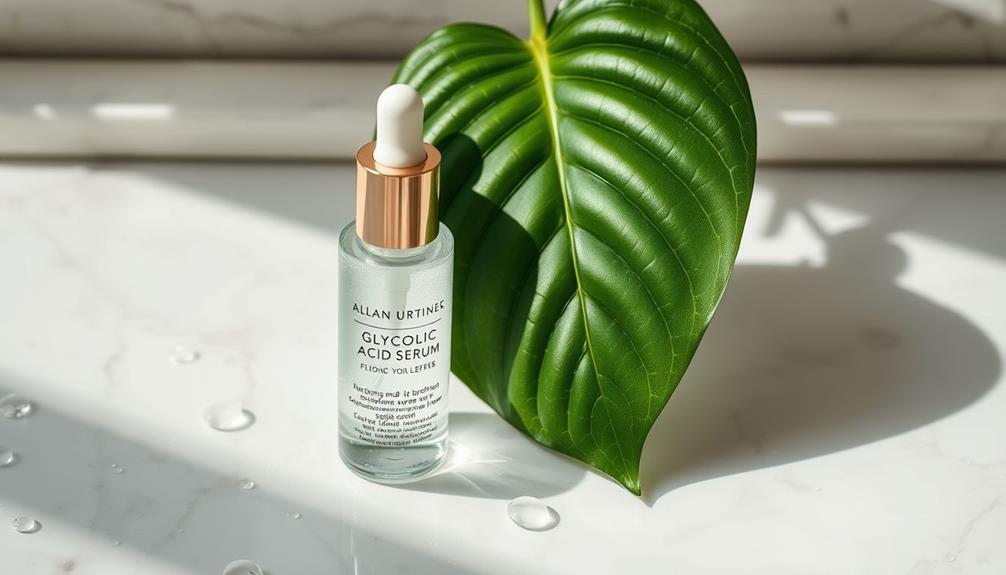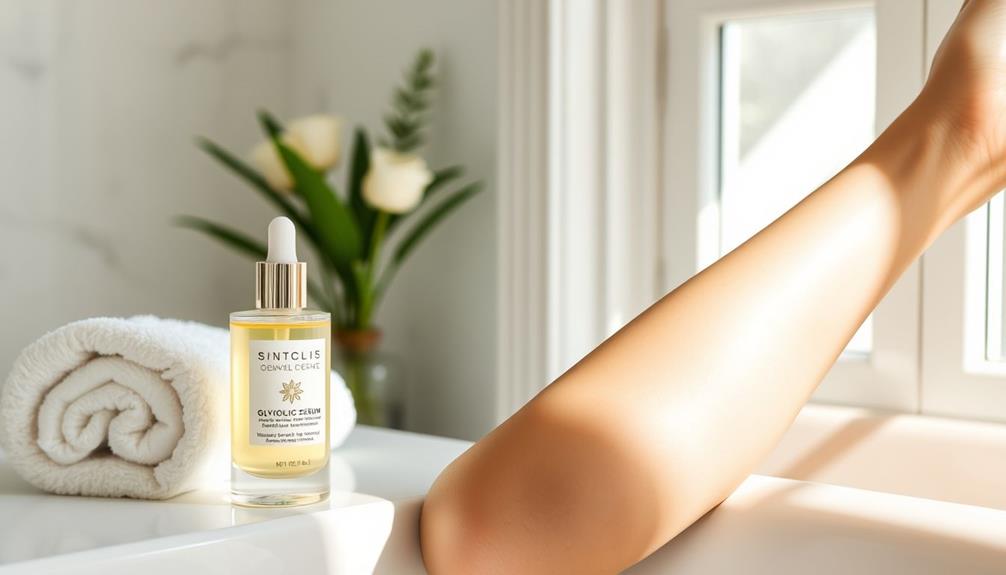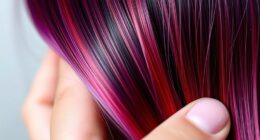Glycolic acid is an incredible ingredient that can rejuvenate your skin. It works as a gentle chemical exfoliant, helping to dissolve dead skin cells and promote a brighter complexion. This powerhouse increases collagen production, improving elasticity and reducing fine lines. You'll find it effective in tackling issues like acne and hyperpigmentation, giving you a more even skin tone. Plus, its humectant properties help keep your skin hydrated and nourished. Just remember to start with lower concentrations and use sunscreen diligently afterward. If you're curious about how to integrate it into your routine, there's more you can explore.
Key Takeaways
- Glycolic acid, derived from sugar cane, acts as a chemical exfoliant that effectively dissolves dead skin cells for a brighter complexion.
- It stimulates collagen production, improving skin elasticity and reducing the appearance of fine lines and wrinkles.
- Regular use helps fade dark spots and hyperpigmentation, promoting an even skin tone and overall skin health.
- Glycolic acid unclogs pores, making it beneficial for treating acne and preventing future breakouts.
What Is Glycolic Acid?

Glycolic acid, derived from sugar cane, is a powerful alpha hydroxy acid (AHA) that penetrates the skin deeply to exfoliate and rejuvenate its surface.
As a chemical exfoliant, it effectively dissolves dead skin cells, promoting a smoother and more radiant complexion.
You'll find glycolic acid in various skincare products, including cleansers, toners, serums, and peels, with concentrations typically ranging from 5% to 30% for over-the-counter options.
This versatile acid addresses multiple skin issues, such as acne, hyperpigmentation, and signs of aging, and can be complemented by natural remedies like essential oils that enhance overall well-being through aromatherapy practices.
By stimulating collagen production, glycolic acid enhances skin elasticity, helping reduce fine lines and wrinkles.
However, it's important to remember that glycolic acid can increase your skin's sensitivity to sunlight. This means you should apply sunscreen diligently when using products containing it.
Incorporating glycolic acid into your skincare routine can offer significant benefits, but you should start with lower concentrations if you're new to AHAs.
Always pay attention to how your skin reacts to avoid irritation, ensuring that you enjoy all the rejuvenating effects glycolic acid has to offer.
How Glycolic Acid Works
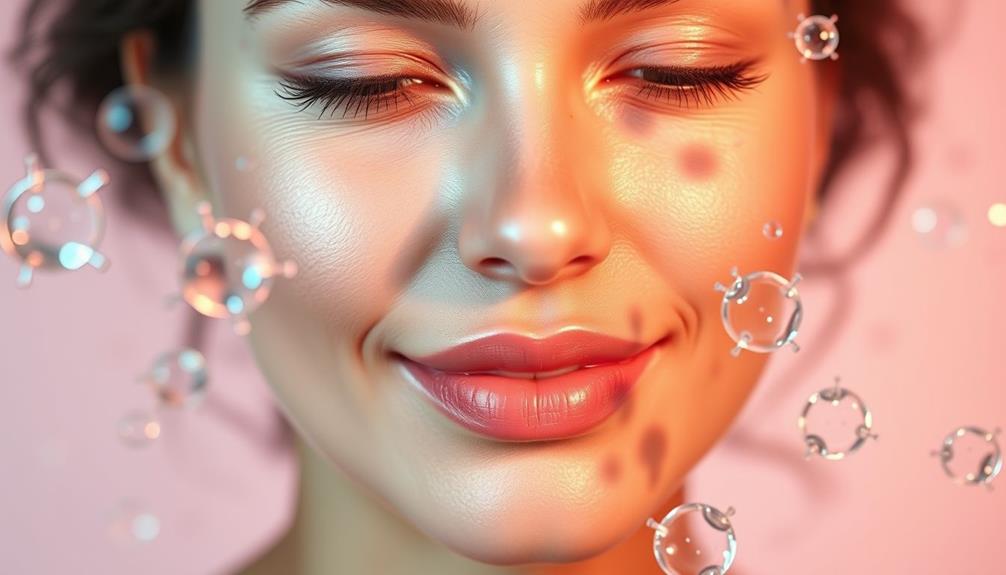
The power of glycolic acid lies in its ability to penetrate deeply into the skin, effectively exfoliating dead cells and revealing a fresher, more radiant complexion. As an alpha-hydroxy acid, it works wonders by promoting cell turnover and enhancing overall skin health. Many people also turn to aromatherapy for skin health to complement their skincare routines.
Here's how glycolic acid works its magic:
- Exfoliation: It dissolves the bonds between skin cells, allowing you to easily exfoliate and uncover healthier skin underneath.
- Collagen Production: Glycolic acid stimulates collagen production, which boosts skin firmness and elasticity, reducing the appearance of fine lines.
- Hydration: With its humectant properties, it attracts moisture to the skin, increasing hydration and improving texture.
- Even Skin Tone: By fading dark patches and hyperpigmentation, glycolic acid helps you achieve a more even skin tone.
Incorporating glycolic acid into your skincare routine can transform your complexion. You'll notice a significant difference as it works to exfoliate, promote cell turnover, and enhance your skin's overall appearance.
Embrace the benefits of glycolic acid, and enjoy a brighter, smoother, and more youthful-looking complexion.
Key Benefits for Skin
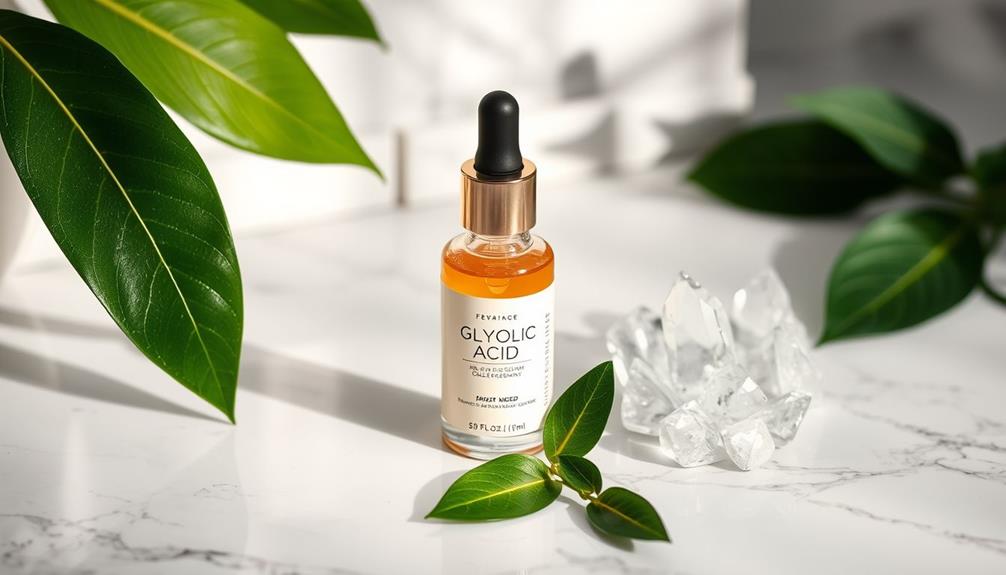
Uncover a myriad of skin benefits with glycolic acid, as it transforms your complexion through powerful exfoliation and hydration.
This potent exfoliant accelerates cell turnover, allowing you to shed dead skin cells and reveal a brighter, smoother skin texture. Incorporating a consistent skincare routine, including gentle yoga stretches, can further enhance your overall skin health.
As you incorporate glycolic acid into your routine, you'll notice an increase in collagen production, which enhances skin firmness and elasticity, helping to reduce the appearance of fine lines.
Not only does glycolic acid work wonders for texture and firmness, but it also helps fade dark patches and hyperpigmentation caused by sun damage or acne. By regularly using this ingredient, you can achieve a more even skin tone that looks refreshed and revitalized.
Glycolic acid is particularly effective for acne treatment, as it unclogs pores and prevents the buildup of dead skin cells that can lead to breakouts.
Additionally, its humectant properties improve hydration by attracting moisture to your skin, leaving it plump and well-nourished.
Application Guidelines
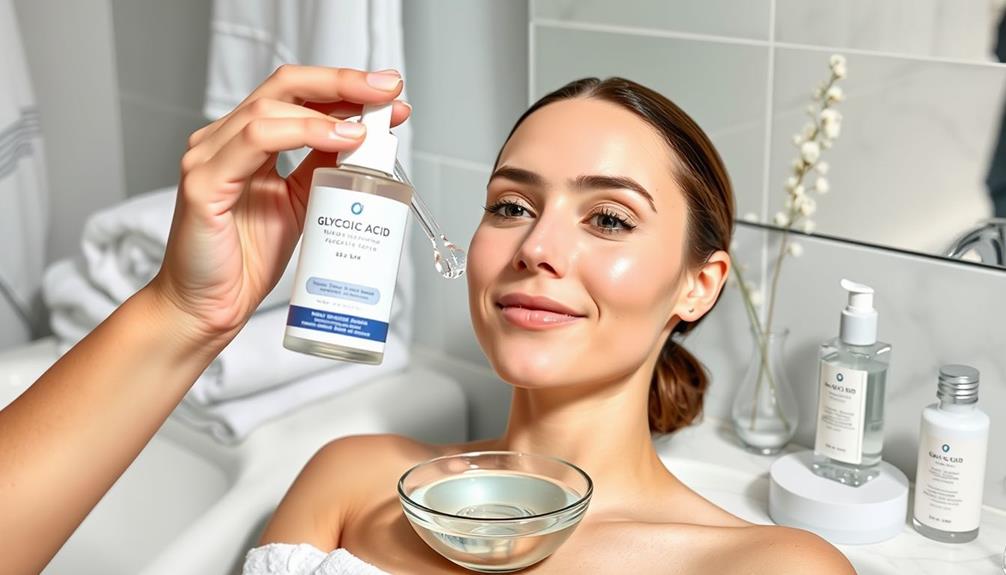
When using glycolic acid, start with lower concentrations to gauge your skin's sensitivity.
It's important to follow guidelines on how often to apply it, as overuse can lead to irritation.
Incorporating mindful practices into your skincare routine can enhance overall well-being, similar to how a holistic lifestyle approach can alleviate menopause symptoms.
Let's explore the best practices for concentration and application frequency to maximize your results.
Concentration Recommendations
Starting with a lower concentration of glycolic acid, around 5-10%, is ideal for beginners and those with sensitive skin to help minimize irritation.
As you explore glycolic acid in your skincare routine, consider these concentration recommendations for safe usage:
- Over-the-Counter Products: Look for products with 5-10% glycolic acid to start, allowing your skin to adjust while evaluating skin tolerance.
- Patch Testing: Always perform patch testing on a small area before full application, especially when introducing higher concentrations, to check for adverse reactions.
- Chemical Peels: If considering chemical peels, consult with a professional for guidance. These typically contain higher concentrations (20-70%) and should be used less frequently, about every one to two weeks.
- Sun Sensitivity: Apply glycolic acid products at night to reduce sun sensitivity and remember to use a broad-spectrum sunscreen during the day to protect your skin.
Application Frequency Tips
To effectively incorporate glycolic acid into your skincare routine, it's important to establish a suitable application frequency that matches your skin's tolerance level.
Start by applying glycolic acid products 2-3 times a week. This allows your skin to adjust before you consider increasing frequency. For over-the-counter products with concentrations up to 10%, daily application at night is usually recommended. However, if you're using higher concentrations, you might want to apply them less frequently.
Keep an eye on your skin's response. If you notice any irritation, reduce your application frequency or switch to a lower concentration until your skin acclimates.
When it comes to glycolic acid peels, it's best to use them once every 1-2 weeks, giving your skin time for recovery in between sessions.
Also, don't forget to use sunscreen during the day. Glycolic acid can increase sun sensitivity, so regular application of sunscreen is essential for protecting your skin.
Safety Precautions
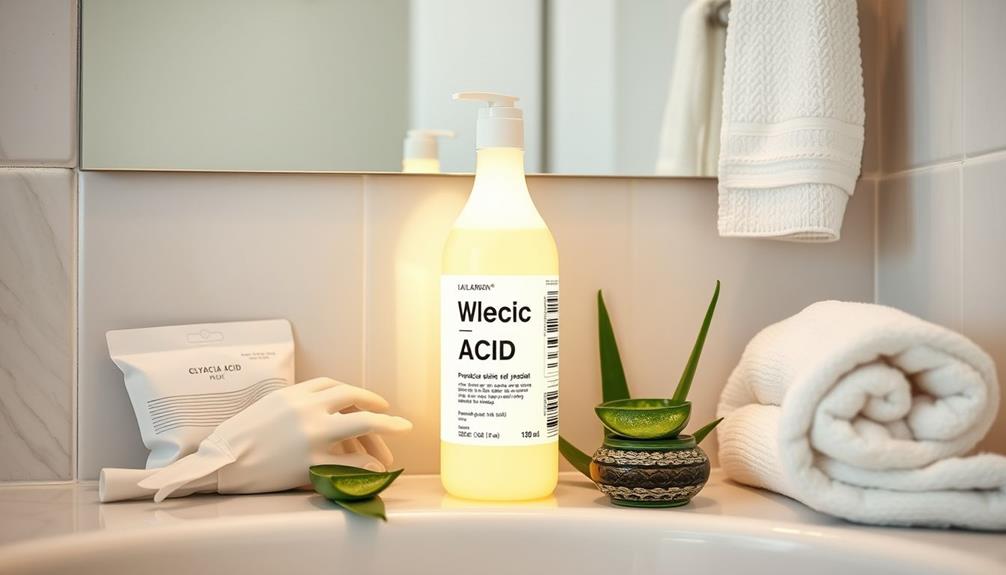
Glycolic acid can frequently cause skin sensitivity, so it's crucial to take proper safety precautions during use. If you're new to glycolic acid or have sensitive skin, following these tips can help you avoid potential irritation and side effects:
- Start with Lower Concentrations: Begin with products containing 5-10% glycolic acid. This allows your skin to adjust and minimizes irritation.
- Conduct a Patch Test: Always perform a patch test on a small area of skin before applying glycolic acid all over your face. This helps you identify any adverse reactions.
- Use Sunscreen: Glycolic acid increases sun sensitivity, so make sure to apply a broad-spectrum sunscreen with at least SPF 30 every day. This protects your skin from harmful UV rays.
- Avoid Mixing Exfoliants: Don't mix glycolic acid with other strong exfoliants or active ingredients, like retinoids or Vitamin C. This can lead to irritation and compromise your skin barrier.
Glycolic Acid and Scarring
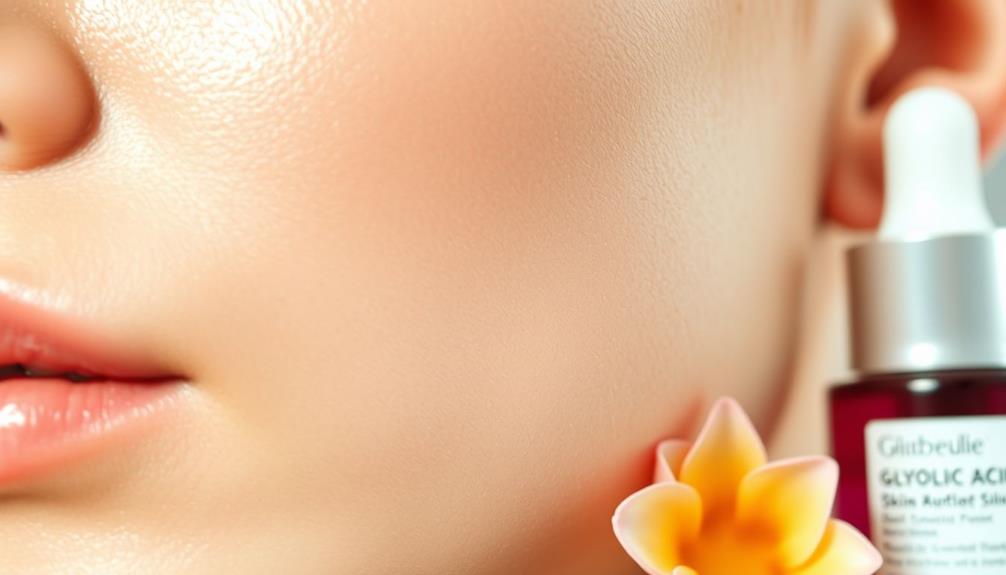
Understanding how glycolic acid affects scarring can help you make informed decisions about incorporating it into your skincare routine for improved skin texture.
Glycolic acid is effective in lightening dark patches from acne scars and wounds, although it won't completely eliminate them. By regularly using glycolic acid, you can exfoliate your skin, which helps soften the appearance of raised and pitted scars over time.
For more significant results, consider professional treatments like chemical peels, which contain higher concentrations of glycolic acid. These treatments can enhance collagen production and promote healthy skin turnover, further improving your skin's texture and helping to prevent new scars from forming.
While glycolic acid is a great addition to your skincare regimen, remember that it's not a standalone solution for scar removal. You might need to explore alternative treatments for ideal results.
Incorporating glycolic acid can be a valuable step in your journey toward smoother skin, but be realistic about your expectations. With consistent use and the right professional guidance, you can achieve noticeable improvements in your skin's overall appearance.
Combining Glycolic Acid With Other Ingredients
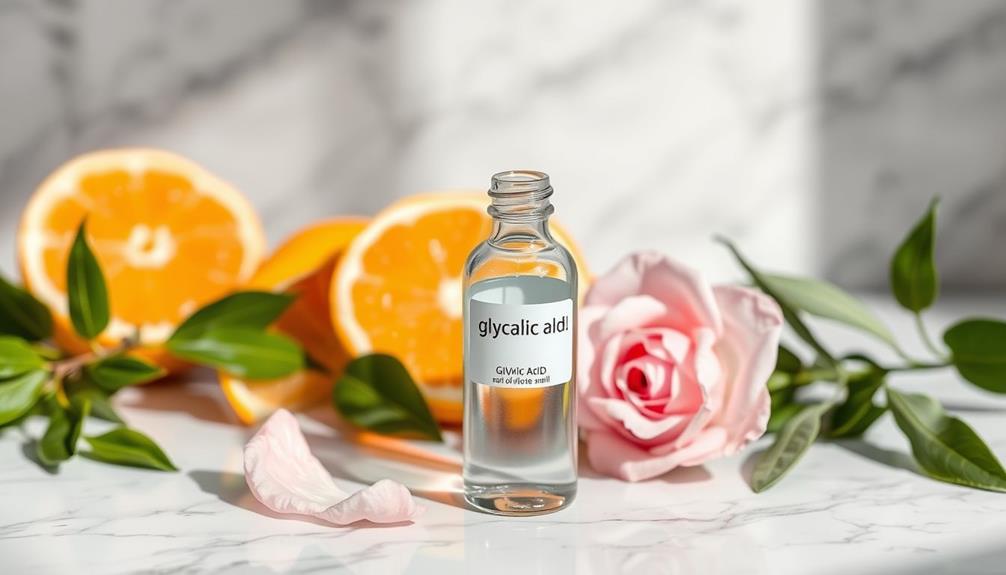
Combining glycolic acid with other powerful ingredients can enhance your skincare routine and target specific concerns effectively. Here are some ideal combinations:
- Glycolic Acid and Retinol: Using these two together on alternate nights can amplify anti-aging effects while minimizing skin irritation.
- Glycolic Acid and Salicylic Acid: Both are exfoliants, so if you have sensitive skin, it's best to use them on different days to avoid irritation.
- Glycolic Acid and Hyaluronic Acid: This combo boosts hydration. Glycolic acid exfoliates, while hyaluronic acid attracts moisture, leading to plumper skin.
- Glycolic Acid and Niacinamide: This pairing balances skin tone and texture. Niacinamide's anti-inflammatory properties can soothe any irritation from glycolic acid.
However, be cautious with Vitamin C; using it at the same time as glycolic acid can lessen their effectiveness. Instead, apply them at different times of the day.
Additional Resources and Studies

To enhance your knowledge about glycolic acid, exploring additional resources and studies can provide deeper insights into its benefits and applications in skincare. Research shows that glycolic acid plays a substantial role in improving skin texture, collagen production, and treating various skin issues like hyperpigmentation and acne scars.
| Study Focus | Key Findings | Recommendations |
|---|---|---|
| Collagen Production | Glycolic acid enhances collagen synthesis | Combine with microneedling for best results |
| Treatment of Melasma | Effective for epidermal melasma | Consider regular chemical peels |
| Skin Hydration | Improves hydration and overall texture | Use alongside other alpha hydroxy acids |
| Importance of Sunscreen | Increases sensitivity to UV rays | Always apply sunscreen after use |
Utilizing glycolic acid through chemical peels or in daily skincare can greatly improve skin conditions. As emphasized by the American Academy of Dermatology, remember to protect your skin with sunscreen to prevent UV damage. By staying informed, you can make the most of glycolic acid's powerful benefits for your skin.
Conclusion
Incorporating glycolic acid into your skincare routine can be a game-changer for your complexion.
With its ability to gently buff away dullness and reveal a brighter, smoother you, it's like giving your skin a rejuvenating wake-up call.
Just remember to follow the guidelines and listen to your skin's needs.
Embrace this powerful ingredient, and watch your skin transform into a radiant canvas that exudes confidence and energy.
You've got this!
